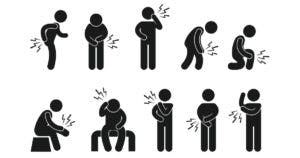By: Dr. Laura Wenger, PT, OCS, FAAOMPT
We have been keeping busy here at Tomsic PT and are, as usual, excited about all of the fun things going on outdoors and in the clinic these days. One thing that many of you may not know about is that our very own Tyrone Deel, marketing coordinator extraordinaire, and Dr. Nathan Dailey, PT, OCS, CSCS, resident strength and conditioning specialist, started a podcast in the fall of 2021. They use their podcast, “The Daily Note”, to touch on a wide variety of topics related to physical therapy, health, and human performance, including strength training, technique, and home exercise programs. It’s very fun to listen to these two chat about these topics in an evidence-based and patient-centered manner.

The most recent episode of the “The Daily Note” from January 2022 touched on an important topic that we have to speak with our patients about frequently- pain. Take a listen if you’ve ever wondered about pain, what it is, and how to manage it. I’ll give you a brief rundown of an important thing that Nathan touched on during this discuss relating to the three types of pain and how they differ1:
- Nociceptive– this could be thought of as a “tissue issue”, such as when you sprain a ligament, strain a muscle, or have joint pain related to a condition such as osteoarthritis.
- Peripheral Neuropathic– this describes “nerve pain”, such as burning or electrical pain caused by a nerve irritation that may also be accompanied with things like tingling, numbness, and weakness.
- Central Sensitization– the most vague of all of the pains, as instead of being caused by a specific tissue injury or nerve irritation, it is driven by your nervous system and brain’s response.

The reality of these classifications of pain, as Nathan describes in the podcast, is that all three types of pain may be present in any individual’s situation but there is usually one that will be the predominant cause of the issue. It is up to us as physical therapists to be able to identify which type of pain is most relevant in your situation in order to best treat you and help you get back toward higher levels of function and tolerance to activity, and that is why our detailed and thorough exam and follow ups help us guide you as best as possible.
Nathan and Tyrone go into the science of pain in much more detail in their conversation. If you’re looking for a knowledge snack in 20 minute or less to learn more about your body and various concepts related to your function and mobility, take some time to check out “The Daily Note”. You can find the episode on Google Podcasts, Stitcher, and Spotify to hear more!
1. Smart KM, Blake C, Staines A, Doody C. Clinical indicators of ‘nociceptive’, ‘peripheral neuropathic’ and ‘central’ mechanisms of musculoskeletal pain. A Delphi survey of expert clinicians. Man Ther 2010;15:80-7.
